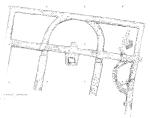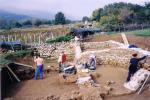Summary (English)
During the fall of 2005, the remains of a church at the site of St. Nicolas, located in a field between Baška and Jurandvor at the foot of the village of Mire were excavated. The three-nave basilica, in the shape of an elongated rectangle, with a semi-circular apse built into the flat back wall, with a total length of slightly more than 28 m and a width of 13.9 m.
The excavations continued in the southern auxiliary room and inside the inner sanctuary of the basilica. Due to the intensive and long-time agricultural activity, the floor inside the apse was completely destroyed, and the mosaic floor covering the southern auxiliary room survived only partially. Two small remains of a multi-coloured mosaic with an interlacing pattern and fan motifs were found. A rectangular depression, an altar grave, was found on the ground in front of the sanctuary. The recess was finely plastered, and that most sacred part of the church was once covered with marble tiles. The altar grave was used to store sacred relics placed in a small coffin. The dimensions and rectangular shape of that recess indicate the time of the construction of the complex until the middle of the 5th century.
The size of the church indicates the number of believers in the nearby settlement of Mire. Earlier finds of well-built grave vaults point to the votive-cemeterial character of the church. The church under Mire was in operation for at least two centuries, judging by the worn out of the remains of the floor mosaic. Traces of fire and collapsed roof speak of a violent end of the church community. So far, it is not possible to speak more precisely about the moment of destruction, but the pagan character of several graves next to the church of St. Lucy from the 9th century clearly determines the beginnings of the arrival of the new Croatian population, who, upon their arrival on the island, occupied cemetery positions next to some already destroyed or abandoned early Christian sanctuaries (Ranko Starac 2006, Hrvatski arheološki godišnjak 2/2005, 274-276).
- Ranko Starac
Director
- Ranko Starac
Team
Research Body
Funding Body
- Ministarstvo kulture Republike Hrvatske






![Download [PDF]](/excavation/skins/fasti/images/results/download_sml.png)
